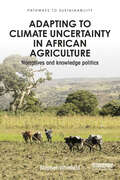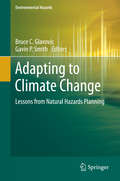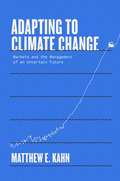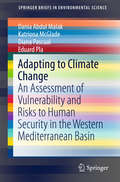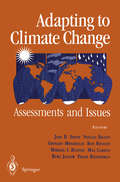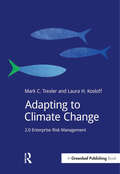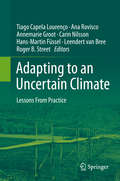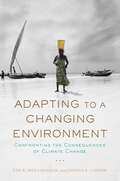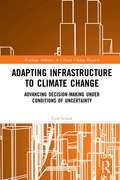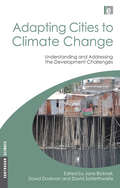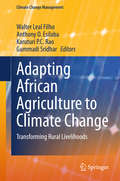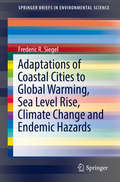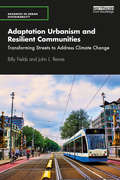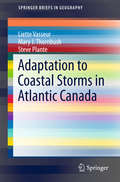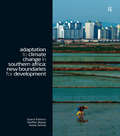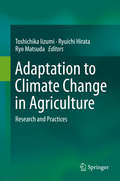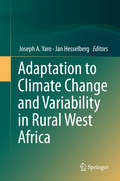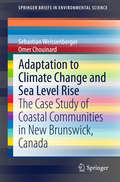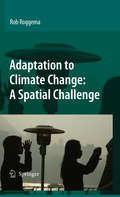- Table View
- List View
Adapting to Climate Uncertainty in African Agriculture: Narratives and knowledge politics (Pathways to Sustainability)
by Stephen WhitfieldFuture climatic and agro-ecological changes in Africa are uncertain and associated with high degrees of spatial and temporal variability and this change is differently simulated within divergent climate-crop models and in controlled crop breeding stations. Furthermore, uncertainty emerges in local contexts, not just in response to climatic systems, but to social, economic, and political systems, and often with implications for the appropriateness and adoption of technologies or the success of alternative cropping systems. This book examines the challenges of adaptation in smallholder farming in Africa, analysing the social, economic, political and climatic uncertainties that impact on agriculture in the region and the range of solutions proposed. Drawing on case studies of genetically modified crops, conservation agriculture, and other 'climate smart' solutions in eastern and southern Africa, the book identifies how uncertainties are framed 'from above' as well experienced 'from below', by farmers themselves. It provides a compelling insight into why ideas about adaptation emerge, from whom, and with what implications. This book offers a unique perspective and will be highly relevant to students of climate change adaptation, food security and poverty alleviation, as well as policy-makers and field practitioners in international development and agronomy.
Adapting to Climate Uncertainty in African Agriculture: Narratives and knowledge politics (Pathways to Sustainability)
by Stephen WhitfieldFuture climatic and agro-ecological changes in Africa are uncertain and associated with high degrees of spatial and temporal variability and this change is differently simulated within divergent climate-crop models and in controlled crop breeding stations. Furthermore, uncertainty emerges in local contexts, not just in response to climatic systems, but to social, economic, and political systems, and often with implications for the appropriateness and adoption of technologies or the success of alternative cropping systems. This book examines the challenges of adaptation in smallholder farming in Africa, analysing the social, economic, political and climatic uncertainties that impact on agriculture in the region and the range of solutions proposed. Drawing on case studies of genetically modified crops, conservation agriculture, and other 'climate smart' solutions in eastern and southern Africa, the book identifies how uncertainties are framed 'from above' as well experienced 'from below', by farmers themselves. It provides a compelling insight into why ideas about adaptation emerge, from whom, and with what implications. This book offers a unique perspective and will be highly relevant to students of climate change adaptation, food security and poverty alleviation, as well as policy-makers and field practitioners in international development and agronomy.
Adapting to Climate Change: Lessons from Natural Hazards Planning (Environmental Hazards)
by Bruce C. Glavovic Gavin P. SmithThis book identifies lessons learned from natural hazard experiences to help communities plan for and adapt to climate change. Written by leading experts, the case studies examine diverse experiences, from severe storms to sea-level related hazards, droughts, heat waves, wildfires, floods, earthquakes and tsunami, in North America, Europe, Australasia, Asia, Africa and Small Island Developing States. The lessons are grouped according to four imperatives: (i) Develop collaborative governance networks; (ii) build adaptive capabilities; (iii) invest in pre-event planning; and (iv) the moral imperative to undertake adaptive actions that advance resilience and sustainability."A theoretically rich and empirically grounded analysis of the interface between disaster risk management and climate change adaptation, comprehensive yet accessible, and very timely." Mark Pelling, Department of Geography, King’s College London, UK. "This book represents a major contribution to the understanding of natural hazards planning as an urgent first step for reducing disaster risk and adapting to climate change to ensure sustainable and equitable development." Sálvano Briceño, Vice-Chair, Science Committee, Integrated Research on Disaster Risk IRDR, an ICSU/ISSC/ISDR programme. Former Director International Strategy for Disaster Reduction, UNISDR.“What a welcome addition to the young literature on climate adaptation and hazard mitigation! Bruce Glavovic and Gavin Smith each bring to the editing task a rare blend of solid scholarly attainment and on-the-ground experience that shines through in this extensively-documented synthesis of theoretical ideas from the realms of climate and hazards and their validation in a rich set of diverse case studies pulled in from around the world. This book should remain a classic for many years.” William H. Hooke, American Meteorological Society.
Adapting to Climate Change: Markets and the Management of an Uncertain Future
by Matthew KahnA revelatory study of how climate change will affect individual economic decisions, and the broad impact of those choicesSelected by Publishers Weekly as one of its Top Ten books in Business and Economics for Spring 2021 It is all but certain that the next century will be hotter than any we’ve experienced before. Even if we get serious about fighting climate change, it’s clear that we will need to adapt to the changes already underway in our environment. This book considers how individual economic choices in response to climate change will transform the larger economy. Using the tools of microeconomics, Matthew E. Kahn explores how decisions about where we live, how our food is grown, and where new business ventures choose to locate are impacted by climate change. Kahn suggests new ways that big data can be deployed to ease energy or water shortages to aid agricultural operations and proposes informed policy changes related to public infrastructure, disaster relief, and real estate to nudge land use, transportation options, and business development in the right direction.
Adapting to Climate Change: An Assessment of Vulnerability and Risks to Human Security in the Western Mediterranean Basin (SpringerBriefs in Environmental Science)
by Dania Abdul Malak Katriona McGlade Diana Pascual Eduard PlaThis book examines the water-related impacts of climate change in the UNESCO Intercontinental Biosphere Reserve of the Mediterranean (IBRM) straddling Spain and Morocco. This is the first in-depth publication on a fascinating transboundary case study; while climate change effects are rather homogenous across the IBRM, differing socio-economic contexts, land-use patterns and policy frameworks in Spain and Morocco mean considerable variations in vulnerability and consequences for human security. The authors have produced a novel and integrated vulnerability assessment that combines hydro-ecological, socio-economic and policy analyses. The interdisciplinary approach and insights contained in this volume will appeal both to those interested in the integration of natural and social sciences as well as those working on water and climate change from academic, practical or policy-oriented perspectives.
Adapting to Climate Change: An International Perspective
by Joel B. Smith Neeloo Bhatti Gennady V. Menzhulin Ron Benioff Max Campos Bubu Jallow Frank Rijsberman Mikhail I. Budyko R. K. DixonGlobal climate change is one of the most important environmental issues facing the world today. The United Nations Framework Convention on Climate Change (FCCC) acknowledges the potential for global climate change to have major effects on the world economy. The work of the Intergovernmental Panel on Cli mate Change (lPCC) is focused on evaluating the scientific data on climate change and analyzing the potential responses to it. One of the primary issues in the global climate change debate is how to adapt to any change that might occur. The process ofidentifying adaptation measures and evaluating their effectiveness is the focus of this book. In dealing with climate change adaptation, the sequence of events in conduct ing these types of analyses can be generalized as follows: • Develop scenarios for the possible range of climate change, • Assess the vulnerability of various sectors of the national economy and infrastructure to climate change, and • Identify and evaluate measures in each sector to adapt to the climate change It is this third step that is the subject of this book. In presenting this material, Chapter 1 gives an overview of the concept of climate change adaptation and the general principles guiding the conduct of analyses in this area. Chapters 2-7 give the results of evaluating climate change adaptation options in the agriculture, water resources, coastal resources, forest and ecosystems, fisheries, and human settlements sectors.
Adapting to Climate Change: 2.0 Enterprise Risk Management
by Mark Trexler Laura KosloffMost companies do not yet recognize what it means to adapt to future climate change, and do not yet see it as a business priority. Adapting to Climate Change tackles two key questions facing decision makers: 1) Is adaptation worth it to me? and 2) If it is worth it, can I really tackle it? If a company has reason to worry about the potential impacts of weather on its operations and supply chains, it probably has cause to worry about climate change. However, "adapting to the weather" is not the same as incorporating climate change adaptation into corporate planning. In the former a company is managing conditions they are already experiencing. The latter involves preparing for forecasted impacts of climate change. Focusing on today’s weather and not tomorrow’s climate leaves a lot of risk on the table, especially if the climate continues to change faster than many climate models have projected. The uncertainties associated with forecasting climate change on a timeframe and at a scale that is relevant to corporate decision making can appear daunting. It is not necessary, however, to have perfect information to advance corporate preparedness for and resilience to climate change. Companies can improve their ability to make robust decisions under conditions of uncertainty without perfect information. A Bayesian approach to reducing uncertainty over time can cost-effectively support companies in understanding and managing many potential climate risks and can avoid the need to depend on future predictions. Instead, initial effort can focus on where a company will have confidence in its analysis and the ability to influence its level of risk, namely in assessing its exposure and vulnerability to climate hazards. As the hazards themselves become more clear, risk management strategies can be quickly adapted.
Adapting to Climate Change: 2.0 Enterprise Risk Management (Doshorts Ser.)
by Mark Trexler Laura KosloffMost companies do not yet recognize what it means to adapt to future climate change, and do not yet see it as a business priority. Adapting to Climate Change tackles two key questions facing decision makers: 1) Is adaptation worth it to me? and 2) If it is worth it, can I really tackle it? If a company has reason to worry about the potential impacts of weather on its operations and supply chains, it probably has cause to worry about climate change. However, "adapting to the weather" is not the same as incorporating climate change adaptation into corporate planning. In the former a company is managing conditions they are already experiencing. The latter involves preparing for forecasted impacts of climate change. Focusing on today’s weather and not tomorrow’s climate leaves a lot of risk on the table, especially if the climate continues to change faster than many climate models have projected. The uncertainties associated with forecasting climate change on a timeframe and at a scale that is relevant to corporate decision making can appear daunting. It is not necessary, however, to have perfect information to advance corporate preparedness for and resilience to climate change. Companies can improve their ability to make robust decisions under conditions of uncertainty without perfect information. A Bayesian approach to reducing uncertainty over time can cost-effectively support companies in understanding and managing many potential climate risks and can avoid the need to depend on future predictions. Instead, initial effort can focus on where a company will have confidence in its analysis and the ability to influence its level of risk, namely in assessing its exposure and vulnerability to climate hazards. As the hazards themselves become more clear, risk management strategies can be quickly adapted.
Adapting to an Uncertain Climate: Lessons From Practice
by Tiago Capela Lourenço Ana Rovisco Annemarie Groot Carin Nilsson Hans-Martin Füssel Leendert Bree Roger B. StreetClimate change highlights the challenges for long-term policy making in the face of persistent and irreducible levels of uncertainties. It calls for the development of flexible approaches, innovative governance and other elements that contribute to effective and adaptive decision-making. Exploring these new approaches is also a challenge for those involved in climate research and development of adaptation policy.The book provides a dozen real-life examples of adaptation decision making in the form of case studies:· Water supply management in Portugal, England and Wales and Hungary· Flooding, including flood risk in Ireland, coastal flooding and erosion in Southwest France, and flood management in Australia’s Hutt River region· Transport and utilities, including the Austrian Federal railway system, public transit in Dresden, and Québec hydro-electric power· Report examining communication of large numbers of climate scenarios in Dutch climate adaptation workshops.
Adapting to a Changing Environment: Confronting the Consequences of Climate Change
by Tim R. McClanahan Joshua CinnerAdapting to a Changing Environment provides tools and a theoretical framework for governments and managers to understand and confront the consequences of climate change. Focusing on coral reefs and the societies that depend on them--the eastern coastline of Africa and the islands of the western Indian Ocean--the authors examine potential problems and solutions. This book offers an up-to-date and original synthesis of environmental stress, natural resources, and the socioeconomics of climate change.
Adapting Infrastructure to Climate Change: Advancing Decision-Making Under Conditions of Uncertainty (Routledge Advances in Climate Change Research)
by Todd SchenkMany of the challenges that decision-makers grapple with in relation to climate change are governance related. Planning and decision-making is evolving in ambiguous institutional environments, in which many key issues remain unresolved, including relationships between different actors; funding arrangements; and the sources and procedures for vetting data. These issues are particularly acute at this juncture, as climate adaptation moves from broad planning processes to the management of infrastructure systems. Concrete decisions must be made. Adapting Infrastructure to Climate Change draws on case studies of three coastal cities situated within very different governance regimes: neo-corporatist Rotterdam, neo-pluralist Boston and semi-authoritarian Singapore. The book examines how infrastructure managers and other stakeholders grappling with complex and uncertain climate risks are likely to make project-level decisions in practice, and how more effective decision-making can be supported. The differences across governance regimes are currently unaccounted for in adaptation planning, but are crucial as best practices are devised. These lessons are also applicable to infrastructure planning and decision-making in other contexts. This book will be of great interest to scholars of climate change and environmental policy and governance, particularly in the context of infrastructure management.
Adapting Infrastructure to Climate Change: Advancing Decision-Making Under Conditions of Uncertainty (Routledge Advances in Climate Change Research)
by Todd SchenkMany of the challenges that decision-makers grapple with in relation to climate change are governance related. Planning and decision-making is evolving in ambiguous institutional environments, in which many key issues remain unresolved, including relationships between different actors; funding arrangements; and the sources and procedures for vetting data. These issues are particularly acute at this juncture, as climate adaptation moves from broad planning processes to the management of infrastructure systems. Concrete decisions must be made. Adapting Infrastructure to Climate Change draws on case studies of three coastal cities situated within very different governance regimes: neo-corporatist Rotterdam, neo-pluralist Boston and semi-authoritarian Singapore. The book examines how infrastructure managers and other stakeholders grappling with complex and uncertain climate risks are likely to make project-level decisions in practice, and how more effective decision-making can be supported. The differences across governance regimes are currently unaccounted for in adaptation planning, but are crucial as best practices are devised. These lessons are also applicable to infrastructure planning and decision-making in other contexts. This book will be of great interest to scholars of climate change and environmental policy and governance, particularly in the context of infrastructure management.
Adapting Cities to Climate Change: Understanding and Addressing the Development Challenges
by David Dodman Jane Bicknell David SatterthwaiteThis volume brings together, for the first time, a wide-ranging and detailed body of information identifying and assessing risk, vulnerability and adaptation to climate change in urban centres in low- and middle-income countries. Framed by an overview of the main possibilities and constraints for adaptation, the contributors examine the implications of climate change for cities in Africa, Asia and Latin America, and propose innovative agendas for adaptation. The book should be of interest to policy makers, practitioners and academics who face the challenge of addressing climate change vulnerability and adaptation in urban centres throughout the global South. Published with E&U and International Institute for Environment and Development
Adapting Cities to Climate Change: Understanding and Addressing the Development Challenges
by David Dodman Jane Bicknell David SatterthwaiteThis volume brings together, for the first time, a wide-ranging and detailed body of information identifying and assessing risk, vulnerability and adaptation to climate change in urban centres in low- and middle-income countries. Framed by an overview of the main possibilities and constraints for adaptation, the contributors examine the implications of climate change for cities in Africa, Asia and Latin America, and propose innovative agendas for adaptation. The book should be of interest to policy makers, practitioners and academics who face the challenge of addressing climate change vulnerability and adaptation in urban centres throughout the global South. Published with E&U and International Institute for Environment and Development
Adapting African Agriculture to Climate Change: Transforming Rural Livelihoods (Climate Change Management)
by Walter Leal Filho Anthony O. Esilaba Karuturi P. C. Rao Gummadi SridharThis book summarizes the evidence from different African countries about the local impacts of climate change, and how farmers are coping with current climate risks. The different contributors show how agricultural systems in developing countries are affected by climate changes and how communities prepare and adapt to these changes.
Adaptations of Coastal Cities to Global Warming, Sea Level Rise, Climate Change and Endemic Hazards (SpringerBriefs in Environmental Science)
by Frederic R. SiegelThis book discusses the identification of, solutions to, and management of threats to high population coastal cities and their seaports from global warming, climate change and endemic hazards. These include prevention of sea water intrusion of freshwater coastal aquifers, emplacement of barriers that mitigate the threats from sea level rise, and inundation of urban centers plus those from storm surges that cause flooding and salination of inshore terrain. The book assesses mitigation of the effects of extreme weather events such as drought, and major flooding from heavy rainfall on coastal urban centers, or on associated drainage basins. It also considers how coastal cities can counter vulnerabilities from other physical hazards (e.g., earthquakes - building codes) and health hazards (e.g., pollution, public health response - preparedness) that may be related to a city’s geological/geographical location and service as a port of entry for goods and travelers (regional and international). The book also cites the high costs of safeguarding citizen and municipal assets, but notes possible sources of potential funding especially from less developed and developing nations. The book is written to give strong background information to students majoring in environmental sciences or those in other majors with interests in the effects of global warming/climate change, and will be of interest to social scientists, think tank personnel, government planners, and lay persons in environmentally oriented organizations.
Adaptation Urbanism and Resilient Communities: Transforming Streets to Address Climate Change (Advances in Urban Sustainability)
by Billy Fields John L. RenneAdaptation Urbanism and Resilient Communities outlines and explains adaptation urbanism as a theoretical framework for understanding and evaluating resilience projects in cities and relates it to pressing contemporary policy issues related to urban climate change mitigation and adaptation. Through a series of detailed case studies, this book uncovers the promise and tensions of a new wave of resilient communities in Europe (Copenhagen, Rotterdam, and London), and the United States (New Orleans and South Florida). In addition, best practice projects in Amsterdam, Barcelona, Delft, Utrecht, and Vancouver are examined. The authors highlight how these communities are reinventing the role of streets and connecting public spaces in adapting to and mitigating climate change through green/blue infrastructure planning, maintaining and enhancing sustainable transportation options, and struggling to ensure equitable development for all residents. The case studies demonstrate that while there are some more universal aspects to encouraging adaptation urbanism, there are also important local characteristics that need to be both acknowledged and celebrated to help local communities thrive in the era of climate change. The book also provides key policy lessons and a roadmap for future research in adaptation urbanism. Advancing resilience policy discourse through multidisciplinary framework this work will be of great interest to students of urban planning, geography, transportation, landscape architecture, and environmental studies, as well as resilience practitioners around the world.
Adaptation Urbanism and Resilient Communities: Transforming Streets to Address Climate Change (Advances in Urban Sustainability)
by Billy Fields John L. RenneAdaptation Urbanism and Resilient Communities outlines and explains adaptation urbanism as a theoretical framework for understanding and evaluating resilience projects in cities and relates it to pressing contemporary policy issues related to urban climate change mitigation and adaptation. Through a series of detailed case studies, this book uncovers the promise and tensions of a new wave of resilient communities in Europe (Copenhagen, Rotterdam, and London), and the United States (New Orleans and South Florida). In addition, best practice projects in Amsterdam, Barcelona, Delft, Utrecht, and Vancouver are examined. The authors highlight how these communities are reinventing the role of streets and connecting public spaces in adapting to and mitigating climate change through green/blue infrastructure planning, maintaining and enhancing sustainable transportation options, and struggling to ensure equitable development for all residents. The case studies demonstrate that while there are some more universal aspects to encouraging adaptation urbanism, there are also important local characteristics that need to be both acknowledged and celebrated to help local communities thrive in the era of climate change. The book also provides key policy lessons and a roadmap for future research in adaptation urbanism. Advancing resilience policy discourse through multidisciplinary framework this work will be of great interest to students of urban planning, geography, transportation, landscape architecture, and environmental studies, as well as resilience practitioners around the world.
Adaptation to Coastal Storms in Atlantic Canada (SpringerBriefs in Geography)
by Liette Vasseur Mary J. Thornbush Steve PlanteThis brief is based on an analysis that was performed on the 2010 winter storms that caused considerable damage to coastal communities in Atlantic Canada. The hazards that occurred were associated with storm surge, high waves, coastal erosion, and flooding. The analysis covered a large multisite longitudinal project, where a participatory action research (PAR) approach was used to understand how people in 10 coastal communities perceive and experience extreme weather events and to enhance their capacity to adapt and improve their resilience. This brief exposes the outcome of two series of interviews and activities that were conducted during the project, as well as the lessons learned, and general elements that should be considered when researchers collaborate with communities to define adaptation and resilience strategies. It makes an important contribution to the application of PAR as an integrated (social-ecological) approach to resilience and how such an approach can be adapted also to other communities.
Adaptation to Climate Change in Southern Africa: New Boundaries for Development (Climate and Development Series)
by Steffen Bauer Imme ScholzAdverse climate impacts are already evident across Southern Africa and pose a serious threat to the development prospects of the region's societies. Sustainable development in this region will depend on the rapid development and implementation of effective adaptation measures. This volume identifies the new socioeconomic and political boundaries to development that result from ongoing climate change in Southern Africa. The collected papers explore the region's potential for a transition to development strategies that combine meaningful socioeconomic investment and adaptation measures while also improving livelihoods in the region. The chapters are backed up by detailed case studies which underscore the urgent need for national governments and multilateral agencies to develop strategies to support Southern Africa's societies in adapting to climate change.
Adaptation to Climate Change in Southern Africa: New Boundaries for Development (Climate and Development Series)
by Steffen Bauer Imme ScholzAdverse climate impacts are already evident across Southern Africa and pose a serious threat to the development prospects of the region's societies. Sustainable development in this region will depend on the rapid development and implementation of effective adaptation measures. This volume identifies the new socioeconomic and political boundaries to development that result from ongoing climate change in Southern Africa. The collected papers explore the region's potential for a transition to development strategies that combine meaningful socioeconomic investment and adaptation measures while also improving livelihoods in the region. The chapters are backed up by detailed case studies which underscore the urgent need for national governments and multilateral agencies to develop strategies to support Southern Africa's societies in adapting to climate change.
Adaptation to Climate Change in Agriculture: Research and Practices
by Toshichika Iizumi Ryuichi Hirata Ryo MatsudaThis book highlights state-of-the-art research and practices for adaptation to climate change in food production systems (agriculture in particular) as observed in Japan and neighboring Asian countries. The main topics covered include the current scientific understanding of observed and projected climate change impacts on crop production and quality, modeling of autonomous and planned adaptation, and development of early warning and/or support systems for climate-related decision-making. Drawing on concrete real-world examples, the book provides readers with an essential overview of adaptation, from research to system development to practices, taking agriculture in Asia as the example. As such, it offers a valuable asset for all researchers and policymakers whose work involves adaptation planning, climate negotiations, and/or agricultural developments.
Adaptation to Climate Change and Variability in Rural West Africa
by Joseph A. Yaro Jan HesselbergThis book presents conceptual and empirical discussions of adaptation to climate change/variability in West Africa. Highlighting different countries’ experiences in adaptation by different socio-economic groups and efforts at building their adaptive capacity, it offers readers a holistic understanding of adaptation on the basis of contextual and generic sources of adaptive capacity. Focusing on adaptation to climate change/variability is critical because the developmental challenges West Africa faces are increasingly intertwined with its climate history. Today, climate change is a major developmental issue for agrarian rural communities with high percentages of the population earning a living directly or indirectly from the natural environment. This makes them highly vulnerable to climate-driven ecological change, in addition to threats in the broader political economic context. It is imperative that rural people adapt to climate change, but their ability to successfully do so may be limited by competing risks and vulnerabilities. As such, elucidating those vulnerabilities and sources of strength with regard to the adaptive capacities needed to support successful adaptation and avoid maladaptation is critical for future policy formulation. Though the empirical discussion is geographically based on West Africa, its applicability in terms of the processes, structures, needs, strategies, and recommendations for policy transcends the region and provides useful lessons for understanding adaptation broadly in the developing world.
Adaptation to Climate Change and Sea Level Rise: The Case Study of Coastal Communities in New Brunswick, Canada (SpringerBriefs in Environmental Science)
by Sebastian Weissenberger Omer ChouinardThe book provides a concise and interdisciplinary outlook on the impacts of climate change on coastal areas and how coastal communities adapt to them. The first chapter analyses how sea level rise, changing ocean conditions, or increased climate variability and the socio-environmental context of the coastal zone leads to vulnerable communities. The second chapter addresses adaptation strategies and tools, and gives some examples of their application around the world. The third chapter describes participative action research projects undertaken in New Brunswick and how this community based approach has enabled communities to increase their climate resilience.
Adaptation to Climate Change: A Spatial Challenge
by Rob RoggemaAs it becomes clear that climate change is not easily within the boundaries of the 1990’s, society needs to be prepared and needs to anticipate future changes due to the uncertain changes in climate. So far, extensive research has been carried out on several issues including the coastal defence or shifting ecozones. However, the role spatial design and planning can play in adapting to climate change has not yet been focused on. This book illuminates the way adaptation to climate change is tackled in water management, ecology, coastal defence, the urban environment and energy. The question posed is how each sector can anticipate climate change by creating spatial designs and plans. The main message of this book is that spatial design and planning are a very useful tool in adapting to climate change. It offers an integral view on the issue, it is capable in dealing with uncertainties and it opens the way to creative and anticipative solutions. Dealing with adaptation to climate change requires a shift in mindset; from a technical rational way of thinking towards an integral proactive one. A new era in spatial design and planning looms on the horizon.
